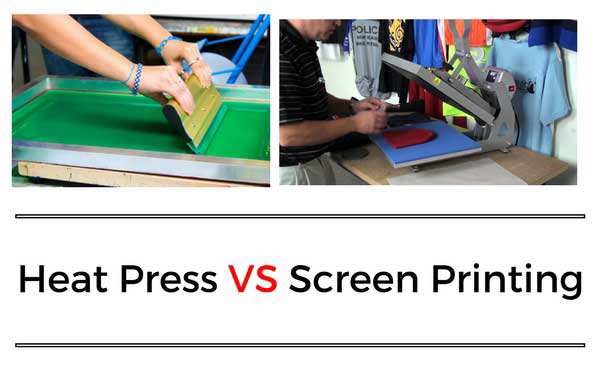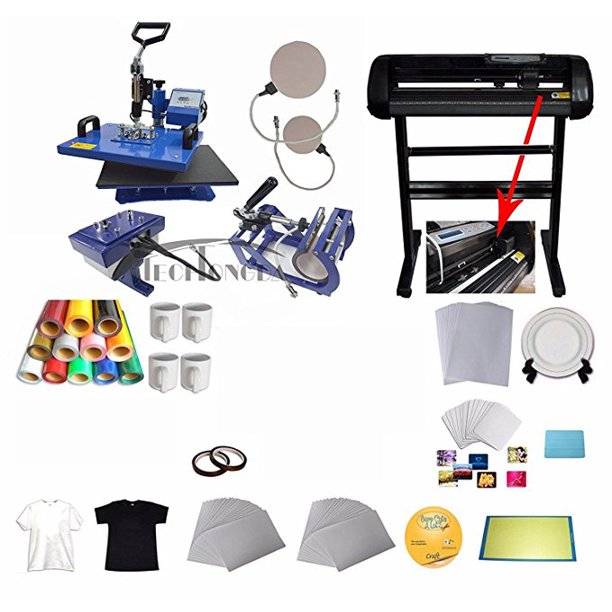
View All Tips & Tricks In Printing Category

Screen Printing vs Heat Press [Differences, Similarities, Pros, Cons]
The printing industry has come a long way. Gone are the days when printing a copy of a newspaper or a book would have taken a day, as the operator tried to move each letter on each page. Technological advances have led to the introduction of faster and more efficient machines that make printing easier and more flexible than ever.
Hot stamping and screen-printing machines are among the recent innovations in the field of printing. To clarify the air, we decided to create this publication to explain the differences and similarities (screen printing vs heat press) between Screen printing and heat press. This will help you make a better decision when you personalize your clothes.
Heat Press:
A hot press is basically a machine that presses its design onto a material, such as a shirt or a card. The device uses high pressure and high-temperature settings to effectively integrate the project into the material permanently. Thermal press printing generally requires about 350-400 degrees Fahrenheit and a pressure setting of 40-80 psi. In this process, he begins to design his artwork on special paper using special ink. Then transfer this design to the garment using the heat provided by a heat press. Now the material applied to the heat has a highly heat-sensitive adhesive on one side.
This ensures that when the heat is applied to the material with a heat press machine, it adheres well to the substrate on which it is being applied. The transfer printing method has gained much popularity in the textile industry. It allows you to print high-quality color images on your clothes. Recent improvements in heat press technology have made this machine completely easy to install and use. Furthermore, it is as fast as you can imagine and it will only take 2-3 minutes to print each item.
It is also good to keep in mind that there are different types and sources of the transfer. A typical transfer consists of inks and backing paper. When applying heat and pressure to this paper, the inks will be transferred to the media on which you are printing. Some transfers are tropical: apply the image on the surface of the head. There are also sublimation transfers, in which the transfer is absorbed into the fibers of the material on which you are printing.
Screen Printing:
Screen printing involves the application of an ink block pattern on a woven network. The model will form an open area through which the ink or any other support that is requested is transferred and pressed onto the garment. Screen printing is the most preferred method for printing different materials, from fabrics, shirts, wood, pens, bottles, business cards, cups, bags, hats and much more. Did you know that this process was invented thousands of years ago? The Chinese invented this invention. Initially, they used screen printing to do the job. Unlike the thermal press, screen printing is a somewhat complicated process that requires more chemicals and equipment for successful printing.
For example, you will need an emulsion to create a screen plus other tree products: removal of the emulsion, ink thinner and faded. These will be used to clean the screen after use. Furthermore, you will need a dark room to store your screens. A screen-printing machine will also be required to print the design on the hand. So, of course, you will need small items like tape, films, scrapers and a printer, about 20 screens, and Plastisol ink. The process of setting up the screen-printing system is the same regardless of whether one or more shirts are being printed.
PROS: screen printing vs heat press
|
Screen Printing |
Heat Press |
| Ideal for larger designs that include one or two colors.
Create a softer feel than the transfer method. Produces a brilliant print, even in darker fabric. ·Silk-screened clothes can resist the roughness of a washing machine because the heat is dry Perfect for printing on cotton or polycotton garments. Convenient for larger projects No size limit; can do all overprints You can iron your print |
·
The process is clean and environmentally friendly, which makes it an excellent choice in today’s health and safety workplace. High-quality end products guaranteed by the use of special inks, as well as the advancement of graphics and software packages that offer greater control and flexibility. Able to use multiple colors as long as they do not overlap It allows you to also press the photographic material They are quite convenient No sign of registration Completely easy to configure and use |
Cons: screen printing vs heat press
|
Screen Printing |
Heat Press |
| Expensive when working on smaller projects.
It is not the perfect option if your design has different colors. If many colors are required, the response time will be longer Separate screens are needed for each color, which means that you will need a new screen for each color in the graphic It takes a long time to install and clean |
Produces better results for light-colored shirts.
It takes a long time: if you’re working on high-quality garments Inability to apply layers of colors as the shirt will appear bulky I can’t iron your print It doesn’t last long |
Which one should you use?
A hot press uses three main factors: time, temperature and pressure, to apply decoration on its material. The machine does not have a minimum, which means that you can order up to 10 shirts and each of them will have a different design. This makes the device ideal for t-shirt customization, as each player has a different name and number. If you are promoting your shirts, you should also consider the heat press as a faster and cheaper alternative. The screen-printing machine has existed for many, many years. And thanks to his fantastic print job, it will exist for thousands of years. If you are in the t-shirt printing business, you should consider this machine given its high-quality end products that your customers will appreciate.
Both technologies are useful, convenient and printing can be performed with simple steps to follow. So, the choice is yours.
16 December, 2021

Heat press vinyl cutter combo
And now for something completely different. If you are the type of person who likes to make custom items, this is a must-have tool in your arsenal. The heat press vinyl cutter combo has everything you need to create your designs and get them out into the world. From cutting tools to adhesive sheets, this machine does not disappoint!
The heat press vinyl cutter combo is perfect for anyone who wants to get into the business of screen printing or just wants a great way to put their creativity on display. This combo machine will save you time and money and become an excellent addition to your home office.
I am pretty sure our list will help you to choose your following product carefully.
List of the 5 Best Heat press vinyl cutter combo
- USCutter 28 – best affordable heat press vinyl cutter combo
- Vinyl Cutter Plotter 5yards – best cheap heat press vinyl cutter combo
- PowerPress Industrial-Quality – best functional heat press vinyl cutter combo
- TECHTONGDA Vinyl Cutter – best durable heat press vinyl cutter combo
- Mophorn Heat Press Machine – best 2-in-1 heat press vinyl cutter combo
Differentiate between Vinyl Cutters and Heat press machines?
Heat press vinyl cutters are tools that combine the functions of a vinyl cutter and heat press. The heat press machines or hot plate machines are used to apply pressure to materials such as fabric, paper, plastics, etc. You can use the machines for many purposes including applying heat transfer vinyl to t-shirts and other clothing items. Heat press vinyl cutters typically have the capability of cutting out shapes from almost any material with precision up to ¼ inch in size.
Cutting vinyl signs and banners is an important part of any sign maker’s process, but it can be tedious.
Heat press machines are a great way to cut down on the time spent cutting vinyl because they heat up and soften the material to make it easier to cut through. Heat press machines also use less force than traditional methods, which means that you’ll get more precise cuts with less effort! Vinyl cutters are used for many different applications in signage making, so if you’re looking for the best vinyl cutter and heat press machine that will work best for your business.
list of 7 Best Heat Press Machines for 2021.
These factors are considered before buying a vinyl cutter:
- Compatibility of Materials
- User interface
- Warranty
- Cost
16 December, 2021
